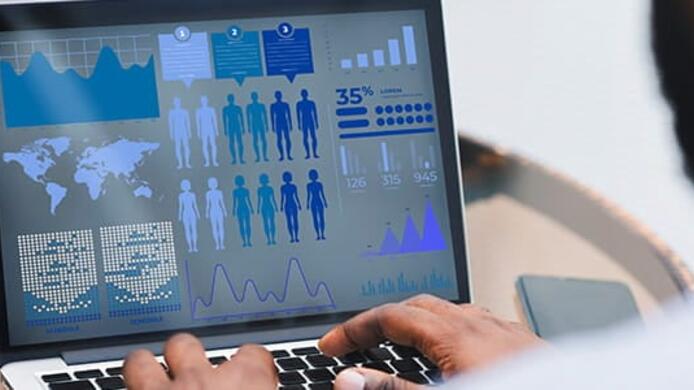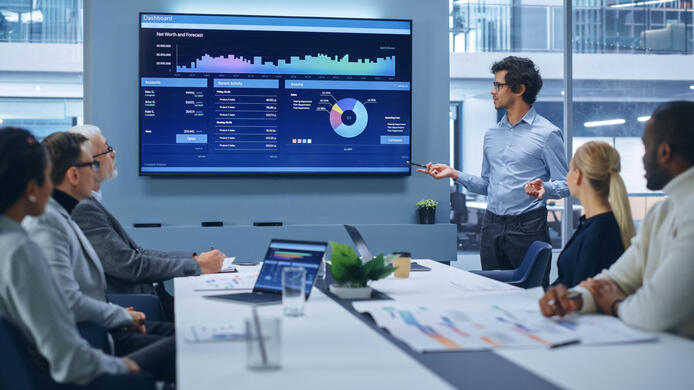Explore our resources for business degrees, like BBA and MBA, and learn about career options that fit your future.

Today, the amount of location (and other) data transmitted from Internet of Things (IoT) devices like smart appliances, watches, and doorbells is astounding — not to mention the data collected from fitness trackers and mobile phones. According to one estimate, around 500 billion devices will be connected to the internet by 2050.
But having enormous quantities of information is only useful if you know how to collect, organize, study, and extrapolate meaningful insights from it. That’s where geospatial analytics comes in.
In an effort to learn more about how to leverage geospatial data to understand the connections between people, places, natural resources, and industries, we sought expert guidance from Dr. Sheila Lakshmi Steinberg, director of the UMass Global Institute for Geospatial Education and professor of GIS (geographic information systems), social and environmental sciences. Join us as we explore the details.
What Are GIS and Geospatial Analytics?
Before we dive into real-life examples of GIS and geospatial data in action, it’s worth reviewing their definitions.
“Geospatial analytics” is a broad term encompassing a variety of techniques used to transform raw geospatial data into usable information and insights. Examples include statistical modeling, data mining, artificial intelligence, machine learning, aerial photo analysis, and other methods used to explore patterns, relationships, and trends within spatial data.
GIS is one of the most well-known and versatile tools in the geospatial intelligence toolkit. “It is essentially computerized mapping,” explains Dr. Steinberg. “GIS incorporates the idea of ‘place and space’ into data, which makes it much more engaging, compelling, and useful.”
UMass Global students have access to cutting edge technology from Esri, the global leader in geospatial tools and technology.
- Inform – GIS tools help decision-makers see the bigger picture and recognize the influence of multiple factors or moving parts.
- Communicate – Using GIS software, you can create interesting and even interactive digital visualizations to help get your point across.
- Influence – Geospatial intelligence and analysis can be a powerful tool for influencing policy and advancing interests through telling stories with maps.
- Empower – There are several GIS platforms that can be used via smartphones; entire populations and communities can use these tools to quantify the challenges they face, identify the resources they lack, and define what change needs to happen.
- Measure – GIS data is essential for measuring the size, shape, and distribution of natural and manmade resources.
3 Examples of Geospatial Analysis Applied Across Industries
The potential uses of GIS and geospatial intelligence are limitless — we’ve only just begun to scratch the surface of possibilities. Analysts and scientists are constantly finding new ways to transform data and incorporate geospatial thinking into strategic decision-making.
Consider the following three examples:
1. Public Health
One of the most recent examples of geospatial intelligence being used at the intersection of public health and emergency management was during the global COVID-19 pandemic response. Countries and organizations around the world leveraged data visualization to map out infection rates, hospitalizations, deaths, and more.
The most prolific site was the Johns Hopkins Corona Virus Dashboard which stopped collecting data on March 10, 2023. This dashboard was central to the world’s awareness of GIS and used spatial data to answer important questions like: Where is this disease? Who is being impacted? How are they being impacted? Where should resources be directed to best solve a problem?
Other useful dashboards were the World Health Organization Coronavirus Dashboard and the U.S. Census COVID Dashboard. Throughout lockdown and well beyond, these free and timely tools helped individuals, policy makers, executives, and employers make informed risk management choices.
2. Marketing and Advertising
Companies of all types and sizes can reap huge benefits from integrating GIS tools and geospatial analytics into their marketing and advertising strategies. Some enterprises — like GrubHub, Lyft, and Waze — base their entire business models around location data.
This is because geospatial intelligence can be used to reach larger audiences and improve customer experience. Consider the following:
- Targeted audience segmentation – Geospatial data is crucial for audience research. Marketers can analyze consumer demographics and buying patterns in a specific geographic location and be aware of how this population moves and shifts over time — and even depending on the specific time of day. The goal is to create customized campaign messaging that appeals to the unique preferences of consumers in each segment.
- Outdoor advertising – Marketers can leverage geospatial analytics to strategically place traditional or digital billboard campaigns, plus other out-of-home advertisements. By analyzing pedestrian and vehicle traffic patterns and consumer buying behaviors, for example, advertisers can identify ad-placement locations that will be highly visible to the target customers for that specific product or service.
- Geofencing – Millions of smartphone users in the U.S. are constantly sharing their data in real time. Companies can use this information to deliver personalized ads, content, and more. For example, fast-food giant McDonald’s recently integrated geofencing technology into their mobile ordering app. Each participating store has an established virtual boundary, and employees are prompted to prepare pickup orders only once the customers are close to the restaurant. This helps lower wait times, improve speed of service, and ensure food is the right temperature upon arrival.
3. Agriculture
Given that growing crops and sustaining food-animal supply depends on the availability of land and water, it’s no surprise that geospatial data is extremely useful across the entire agricultural sector. GIS tools can be used to accomplish the following:
- Plan efficient irrigation systems
- Reduce environmental impact
- Monitor crops
- Optimize resource management
- Implement precision agriculture practices
Another important agricultural application of GIS and geospatial intelligence is in land use planning — the process of determining whether an area should be used for development, conservation, farming, or mixed uses. Dr. Steinberg notes that every decision also has a social component to consider, which often is overlooked.
This was true with the Agricultural Worker Health Initiative Project conducted in California’s Monterey and Tulare counties. Dr. Steinberg shares that this was one of the most impactful uses of GIS in her career. Together with colleague Dr. Steven Steinberg, she led a team of students in an effort to discover why migrant farmworkers and their children were suddenly getting sick.
After painstakingly plotting points, interviewing workers, and asking lots of questions, they used geospatial software to identify key patterns. They found that farmers had started spraying pesticide at night, and it was drifting into nearby schools and homes.
Together with the farmworkers and their families, the team recommended adding mandatory buffer zones around schools and residences, which are commonly located next to agricultural fields in rural areas.
“We are really proud of that study,” Dr. Steinberg affirms. “It didn’t happen overnight, but eventually new policies were implemented based on our suggestions.” She went on to co-author a book entitled Resilient Communities Across Geographies that explores this case and others in detail.
Are You Ready to Harness the Power of Geospatial Analytics?
It’s easy to see why geospatial analytics skills are in demand across businesses, governments, industries, organizations, agencies, and nonprofits. We know that better decisions emerge when data is visualized, stories are told, and people and places are accurately considered.
If you are interested in learning how to think geospatially, reach out to a UMass Global enrollment coach at (800) 746-0082 or check out our certificate, undergraduate, and graduate program offerings:
Online GIS graduate certificates:
Online undergraduate GIS and related degrees:
Online GIS-related graduate degrees:








